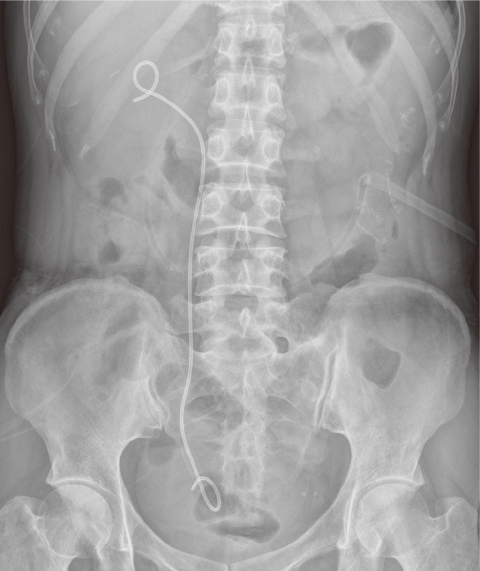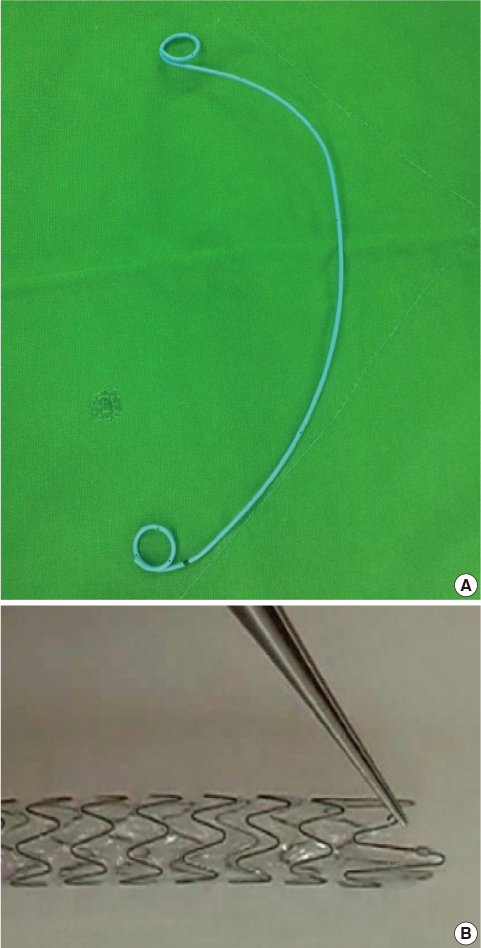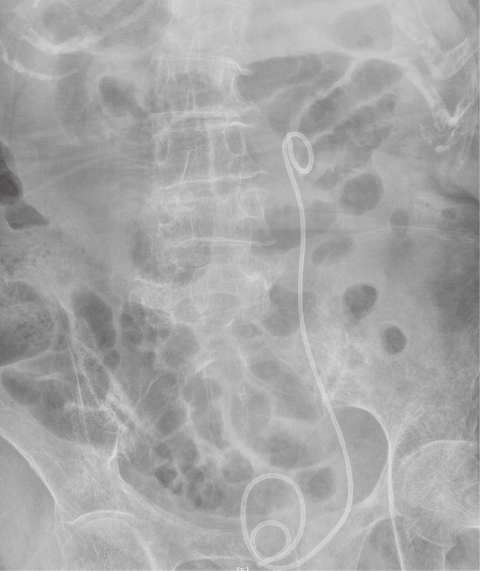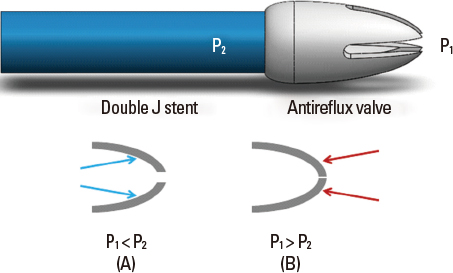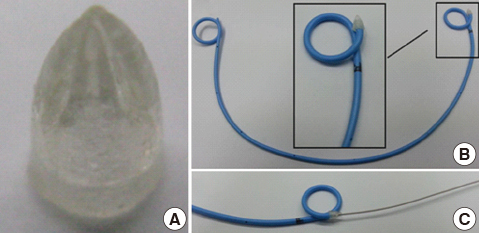Hanyang Med Rev.
2013 Aug;33(3):178-184. 10.7599/hmr.2013.33.3.178.
Adverse Effects of Ureteral Stent and Development of the Antireflux Ureteral Stent
- Affiliations
-
- 1Department of Urology, Hanyang University College of Medicine, Guri, Korea. moonuro@hanyang.ac.kr
- 2Department of Medical System Engineering, Gwangju Institute of Science and Technology (GIST), Gwangju, Korea.
- KMID: 2168266
- DOI: http://doi.org/10.7599/hmr.2013.33.3.178
Abstract
- The double J ureteral stent (D-J stent) represents the ureteral catheter widely used nowadays. The main purpose of the D-J stent is to resolve ureteral obstruction caused by intraureteral or extra-ureteral etiologies. Indications of D-J stents have been extended and it has become one of the most important surgical instruments that protect the kidney and ureter. The ideal D-J stent should be easy to insert and remove and should not cause any adverse effects in vivo. In addition, it has to function well. However, there has been no immaculate D-J stent because our body conceives the ureteral stent as a foreign object and numerous developments are being made in order to overcome it. Vesicoureteral reflux, one of the adverse effects of the D-J stent, is the most troublesome adverse effect because it may scar the renal parenchyma, leading to permanent deterioration of renal function. This review is to discuss adverse effects of ureteral stents and to present the novel antireflux D-J stent that may reduce vesicoureteral reflux.
MeSH Terms
Figure
Cited by 1 articles
-
Role of Experimental Research as a Surgeon
Hwon Kyum Park
Hanyang Med Rev. 2013;33(3):139-141. doi: 10.7599/hmr.2013.33.3.139.
Reference
-
1. Zimskind PD, Fetter TR, Wilkerson JL. Clinical use of long-term indwelling silicone rubber ureteral splints inserted cystoscopically. J Urol. 1967; 97:840–844.
Article2. Finney RP. Experience with new double J ureteral catheter stent. J Urol. 1978; 120:678–681.
Article3. Lumiaho J, Heino A, Aaltomaa S, Valimaa T, Talja M. A short biodegradable helical spiral ureteric stent provides better antireflux and drainage properties than a double-J stent. Scand J Urol Nephrol. 2011; 45:129–133.
Article4. Dyer RB, Chen MY, Zagoria RJ, Regan JD, Hood CG, Kavanagh PV. Complications of ureteral stent placement. Radiographics. 2002; 22:1005–1022.
Article5. Damiano R, Oliva A, Esposito C, De Sio M, Autorino R, D'Armiento M. Early and late complications of double pigtail ureteral stent. Urol Int. 2002; 69:136–140.
Article6. Joshi HB, Okeke A, Newns N, Keeley FX Jr, Timoney AG. Characterization of urinary symptoms in patients with ureteral stents. Urology. 2002; 59:511–516.
Article7. Moon KT, Cho HJ, Cho JM, Kang JY, Yoo TK, Moon HS, et al. Comparison of an Indwelling Period Following Ureteroscopic Removal of Stones between Double-J Stents and Open-Ended Catheters: A Prospective, Pilot, Randomized, Multicenter Study. Korean J Urol. 2011; 52:698–702.
Article8. Cummings LJ, Waters SL, Wattis JA, Graham SJ. The effect of ureteric stents on urine flow: reflux. J Math Biol. 2004; 49:56–82.
Article9. Al-Aown A, Kyriazis I, Kallidonis P, Kraniotis P, Rigopoulos C, Karnabatidis D, et al. Ureteral stents: new ideas, new designs. Ther Adv Urol. 2010; 2:85–92.
Article10. Venkatesan N, Shroff S, Jayachandran K, Doble M. Polymers as ureteral stents. J Endourol. 2010; 24:191–198.
Article11. Pedro RN, Hendlin K, Kriedberg C, Monga M. Wire-based ureteral stents: impact on tensile strength and compression. Urology. 2007; 70:1057–1059.
Article12. Liatsikos E, Kallidonis P, Stolzenburg JU, Karnabatidis D. Ureteral stents: past, present and future. Expert Rev Med Devices. 2009; 6:313–324.
Article13. Pollard SG, Macfarlane R. Symptoms arising from Double-J ureteral stents. J Urol. 1988; 139:37–38.
Article14. Lennon GM, Thornhill JA, Sweeney PA, Grainger R, McDermott TE, Butler MR. 'Firm' versus 'soft' double pigtail ureteric stents: a randomised blind comparative trial. Eur Urol. 1995; 28:1–5.
Article15. Chua ME, Morales ML Jr. Spontaneous fracture of indwelling polyurethane ureteral stents: A case series and review of literature. Can Urol Assoc J. 2012; 6:386–392.
Article16. Slaton JW, Kropp KA. Proximal ureteral stent migration: an avoidable complication? J Urol. 1996; 155:58–61.
Article17. Singh I, Gupta NP, Hemal AK, Aron M, Seth A, Dogra PN. Severely encrusted polyurethane ureteral stents: management and analysis of potential risk factors. Urology. 2001; 58:526–531.
Article18. Robert M, Boularan AM, El Sandid M, Grasset D. Double-J ureteric stent encrustations: clinical study on crystal formation on polyurethane stents. Urol Int. 1997; 58:100–104.
Article19. Somers WJ. Management of forgotten or retained indwelling ureteral stents. Urology. 1996; 47:431–435.
Article20. Arshad M, Shah SS, Abbasi MH. Applications and complications of polyurethane stenting in urology. J Ayub Med Coll Abbottabad. 2006; 18:69–72.21. Kumar M, Aron M, Agarwal AK, Gupta NP. Stenturia: An unusual manifestation of spontaneous ureteral stent fragmentation. Urol Int. 1999; 62:114–116.
Article22. Bergqvist D, Parsson H, Sherif A. Arterio-ureteral fistula--a systematic review. Eur J Vasc Endovasc Surg. 2001; 22:191–196.23. el-Faqih SR, Shamsuddin AB, Chakrabarti A, Atassi R, Kardar AH, Osman MK, et al. Polyurethane internal ureteral stents in treatment of stone patients: morbidity related to indwelling times. J Urol. 1991; 146:1487–1491.
Article24. Griffiths DJ. Dynamics of the upper urinary tract: I. Peristaltic flow through a distensible tube of limited length. Phys Med Biol. 1987; 32:813–822.
Article25. Griffiths DJ, Constantinou CE, Mortensen J, Djurhuus JC. Dynamics of the upper urinary tract: II. The effect of variations of peristaltic frequency and bladder pressure on pyeloureteral pressure/flow relations. Phys Med Biol. 1987; 32:823–833.
Article26. Mosli HA, Farsi HM, al-Zimaity MF, Saleh TR, al-Zamzami MM. Vesicoureteral reflux in patients with double pigtail stents. J Urol. 1991; 146:966–969.
Article27. Irani J, Siquier J, Pires C, Lefebvre O, Dore B, Aubert J. Symptom characteristics and the development of tolerance with time in patients with indwelling double-pigtail ureteric stents. BJU Int. 1999; 84:276–279.
Article28. Maheshwari PN, Andankar MG, Khera R, Stone RG. The indwelling ureteric stent: a 'friendly' procedure with unfriendly high morbidity. BJU Int. 2000; 86:757–758.
Article29. Richter S, Ringel A, Shalev M, Nissenkorn I. The indwelling ureteric stent: a 'friendly' procedure with unfriendly high morbidity. BJU Int. 2000; 85:408–411.
Article30. Tschada R, Mickisch G, Rassweiler J, Knebel L, Alken P. [Success and failure with double J ureteral stent. Analysis of 107 cases]. J Urol (Paris). 1991; 97:93–97.31. Hubner WA, Plas EG, Trigo-Rocha F, Tanagho EA. Drainage and reflux characteristics of antireflux ureteral double-J stents. J Endourol. 1993; 7:497–499.
Article32. Ecke TH, Bartel P, Hallmann S, Ruttloff J. Evaluation of symptoms and patients' comfort for JJ-ureteral stents with and without antireflux-membrane valve. Urology. 2010; 75:212–216.
Article33. Lasaponara F, Catti M, Morabito F, Volpe A, Manassero F, Ferrando U. Use of small calibre JJ ureteral stent with anti-reflux valve in uretero-vesical anastomosis during renal transplantation. Minerva Urol Nefrol. 2000; 52:195–199.
- Full Text Links
- Actions
-
Cited
- CITED
-
- Close
- Share
- Similar articles
-
- Recent Advances in Ureteral Stents
- Percutaneous placement of ureteral stent
- Proximal Migration of Ureteral Stent after Extracorporeal Shock Wave Lithotripsy
- Predictor for Ureteral Stent Removal in Gynecological Cancer Patients with a Ureteral Obstruction
- Removal of Migrated Thermo-Expandable Ureteral Stent (Memokath): Open Procedure 1 Case

